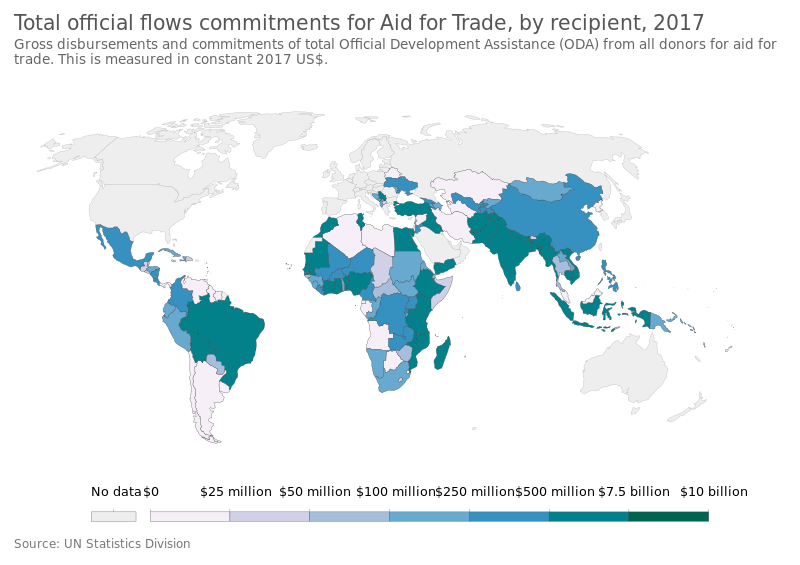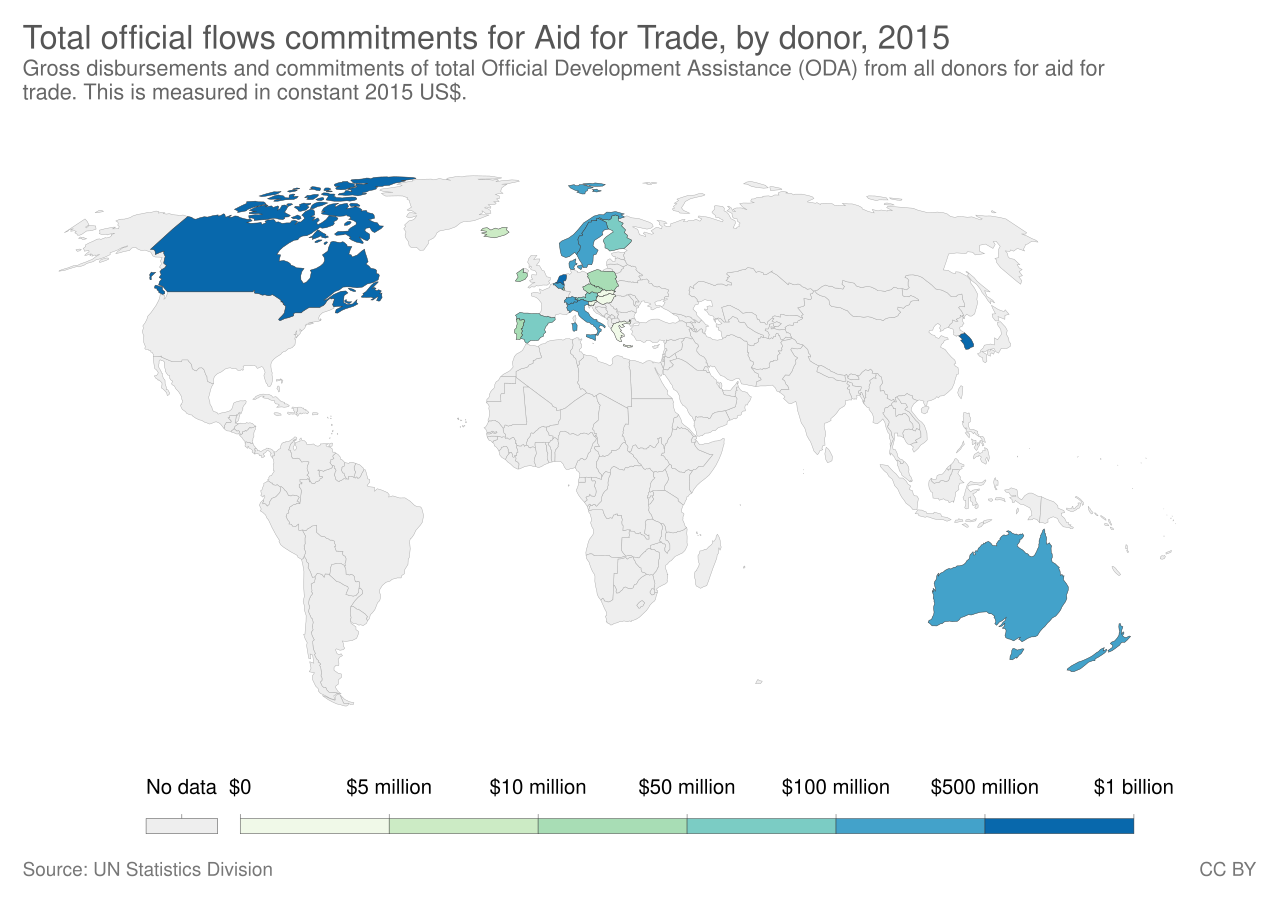AQA Specification focus:
‘The role of aid and trade in promoting growth and development.’
Introduction
Aid and trade are key instruments through which countries promote economic growth and development, particularly in less-developed economies. Understanding how they complement and differ is crucial for evaluating global economic progress.
Understanding Aid and Trade
Aid and trade are both external means of supporting development. However, their mechanisms, objectives, and long-term impacts differ considerably.
Aid: The transfer of resources from one country or international organisation to another, often to support economic development or humanitarian relief.
Trade: The exchange of goods and services between countries, enabling specialisation and access to broader markets.
Both mechanisms aim to reduce poverty, stimulate investment, and encourage sustainable economic growth, but they operate under different time horizons and conditions.
Types of Aid
Aid can be classified into several categories, each serving distinct purposes within development economics.
1. Bilateral Aid
Provided directly from one government to another.
Often tied to political or strategic interests.
Example: The UK’s aid to Commonwealth nations through the Foreign, Commonwealth and Development Office (FCDO).
2. Multilateral Aid
Distributed through international organisations such as the World Bank, IMF, or United Nations Development Programme (UNDP).
Aims for large-scale, coordinated development projects.
3. Humanitarian Aid
Short-term aid provided during crises such as natural disasters or conflicts.
Focused on immediate relief, not long-term development.
4. Developmental Aid
Long-term assistance intended to improve infrastructure, education, and healthcare.
Seeks to foster self-sustaining economic growth.
5. Tied Aid
Conditional aid requiring recipients to purchase goods or services from the donor country.
Often criticised for reducing the efficiency and autonomy of recipient nations.
Effectiveness of Aid in Promoting Development
Aid can have both positive and negative effects on economic development.
Positive Effects
Infrastructure investment: Builds roads, schools, and hospitals, improving productivity and living standards.
Human capital development: Funding for education and healthcare raises the quality of the workforce.
Stabilisation support: Helps governments maintain fiscal stability during crises.
Technology transfer: Encourages adoption of advanced technologies in developing economies.
Negative Effects
Dependency: Long-term reliance on aid can discourage domestic revenue generation and reform.
Corruption: Funds may be misallocated or diverted due to weak institutions.
Distortion of local markets: Free or subsidised goods can undermine local producers.
Tied conditions: Can prioritise donor interests over recipient needs.

The chart depicts the total official flows committed to aid for trade by recipient country, measured in constant 2017 US dollars. It highlights the varying levels of aid allocation across different nations, emphasizing the global distribution of trade-related development assistance. Source
Trade as a Driver of Growth and Development
Trade allows developing nations to specialise according to their comparative advantage, boosting productivity and income levels.
Comparative Advantage: The ability of a country to produce a good at a lower opportunity cost than another country.
By engaging in international trade, countries can:
Access larger markets and achieve economies of scale.
Increase foreign exchange earnings from exports.
Encourage foreign direct investment (FDI) and technology transfer.
Diversify their economies beyond traditional sectors like agriculture.
The Role of Free Trade in Development
Promoting free trade can stimulate development, but benefits depend on the structure and readiness of a country’s economy.
Benefits of Free Trade
Efficiency gains through competition.
Resource allocation according to comparative advantage.
Export-led growth, particularly in East Asian economies like South Korea and Taiwan.
Lower prices and greater consumer choice.
Challenges
Infant industry vulnerability: New industries in developing countries may struggle against established global firms.
Terms of trade deterioration: Developing nations often export low-value goods and import high-value goods.
Unequal gains: Benefits of trade may be concentrated in certain sectors or regions.

The chart illustrates the total official flows committed to aid for trade by donor country, measured in constant 2017 US dollars. It underscores the contributions of various donor nations to enhancing trade capacities in developing countries. Source
Interaction Between Aid and Trade
Aid and trade are not mutually exclusive; they often reinforce one another.
Aid for Trade (AfT) initiatives support developing countries in building trade capacity—improving ports, customs, and logistics.
Infrastructure aid facilitates export growth by reducing transportation and production costs.
Policy-based aid can help governments reform trade laws to enhance competitiveness.
Combining aid with trade policies fosters inclusive and sustainable development.
The Role of International Institutions
Several international organisations coordinate aid and trade to promote development globally.
World Bank
Provides long-term development loans for infrastructure and poverty reduction projects.
International Monetary Fund (IMF)
Offers financial stability support and policy advice to improve economic management.
World Trade Organisation (WTO)
Oversees global trade rules to ensure fairness and reduce barriers.
United Nations Development Programme (UNDP)
Works on poverty reduction, governance, and capacity-building in developing nations.
These institutions aim to harmonise global economic cooperation and address structural inequalities in trade and development.
Trade vs Aid Debate
Economists and policymakers continue to debate whether aid or trade is more effective in promoting sustainable development.
Arguments for Trade
Encourages self-sufficiency and reduces long-term dependency.
Promotes private sector growth and innovation.
Generates stable revenue through exports rather than temporary aid flows.
Arguments for Aid
Essential for humanitarian relief and institutional development.
Can address market failures and provide a foundation for later trade success.
Useful for post-conflict reconstruction and public goods investment.
The most effective approach often combines both, ensuring that aid supports trade capacity and institutional development.
Evaluating the Role of Aid and Trade
The success of aid and trade policies depends on:
The quality of governance in recipient nations.
The structure of global trade agreements.
The extent of market access granted by developed economies.
The coordination between donors, multilateral agencies, and domestic policymakers.
When managed effectively, aid can create the groundwork for trade-led growth, while trade can sustain the benefits of aid-driven development.
FAQ
Tied aid requires the recipient country to use the funds to purchase goods or services from the donor country, limiting flexibility and often increasing costs.
Untied aid, on the other hand, allows recipients to spend the funds as needed, typically leading to more efficient allocation and greater local economic benefit.
Aid for Trade focuses specifically on helping developing nations build the capacity to trade internationally by improving infrastructure, trade policies, and skills.
Traditional development aid targets broader objectives such as poverty reduction, education, and healthcare without necessarily linking to trade outcomes.
Trade generates ongoing revenue through exports, encouraging self-reliance and innovation. It fosters competition and attracts foreign investment.
Aid, by contrast, can create dependency if not managed effectively and may fluctuate based on donor priorities, making it less predictable for long-term planning.
Aid for Trade helps by:
Upgrading transport and port infrastructure to reduce costs.
Simplifying customs and regulatory procedures.
Training workers and firms to meet international standards.
These improvements enhance export competitiveness and expand access to global markets.
The success of aid depends on several factors:
Strength of governance and institutional capacity.
How well aid aligns with national trade priorities.
Coordination among donors and local stakeholders.
Stability and transparency in the political environment.
When these conditions are met, aid can lay the foundation for sustainable trade-driven growth.
Practice Questions
Define the term 'Aid for Trade'. (2 marks)
1 mark for identifying that Aid for Trade refers to assistance aimed at improving trade-related capacities in developing countries.
1 additional mark for stating that it supports areas such as infrastructure, trade policy, and export competitiveness.
Explain how both aid and trade can contribute to the economic development of less-developed countries. (6 marks)
1 mark for identifying that aid can provide capital for infrastructure and human development.
1 mark for explaining that aid can address market failures and improve public services.
1 mark for recognising that trade allows specialisation based on comparative advantage.
1 mark for explaining that trade increases access to foreign markets and investment inflows.
1 mark for linking aid and trade to long-term sustainable growth through productivity and income improvements.
1 mark for clarity and coherence in linking both mechanisms to development outcomes.

